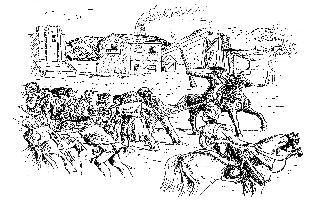Battle of Cinderloo
 In June 1820, following stagnation in the iron industry, colliery owners in Dawley attempted to lower the wages of their workforces. Violence attended the ensuing miners’ strike, but this was quelled by the Shropshire Yeomanry and the owners, realising how determined the men were, relented.
In June 1820, following stagnation in the iron industry, colliery owners in Dawley attempted to lower the wages of their workforces. Violence attended the ensuing miners’ strike, but this was quelled by the Shropshire Yeomanry and the owners, realising how determined the men were, relented.
A few months later the wage reduction was again proposed. On February 1st 1821 colliers went on strike and enlisted support of men at the local ironworks where production was successfully halted. The following day, striking colliers, many armed with sticks, left Donnington Wood to remove the plugs from furnaces at Old Park Ironworks, their numbers swelling as they went. From Old Park, they continued onto the ironworks at Lightmoor, then those at Dawley Castle and Horsehay with the intention of ending their march at Coalbrookdale. However, by the time they had reached Horsehay, news of their actions had led to the Shropshire Yeomanry and Special Constables being summoned. Instead of continuing their journey south, they started to return north and by 3 O’clock that afternoon their numbers had swelled to over 3,000 and the crowd included women and children
The employers, alarmed at the turn of events, sent urgent appeals for help, but it was clear that the local constabulary would be inadequate. The Shropshire Yeomanry, led by Colonel Cludde, was once again summoned.
By the time the Yeomanry arrived, the crowd had gathered near two industrial spoil heaps, known as the ‘Clinder Hills’, in the vicinity of the Old Park Works. As the accompanying magistrate started to read the Riot Act the miners began hurling stones and lumps of cinders at the troops. They moved forward nonetheless, and began seizing the ringleaders, whilst the crowd secured positions on the cinder hills and continued to throw material. Colonel Cludde ordered his men to open fire, and in the ensuing mayhem, two miners were killed. Shocked and dismayed, the miners’ appetite for a fight evaporated and they dispersed.
Of the nine captives, Thomas Palin and Samuel Hayward were later sentenced to death. Palin was hanged – despite appeals for clemency by employers – but Hayward was reprieved. The rest earnt nine months hard labour, an ironic sentence for a 19C miner. In the aftermath of the riot, many miners’ families were left destitute as jobs were lost following the damage to pit equipment. The wage cuts were inevitably forced through.
Echoing the bloody suppression of working people by the cavalry in Manchester just 18 months earlier, known as the ‘Peterloo Massacre’ (itself an ironic reference to the Battle of Waterloo four years earlier) the incident in Dawley entered the folk-lore of the East Shropshire Coalfield, remembered locally as the ‘Battle of Cinderloo’.

